英美诗歌选读 第三讲
- 格式:doc
- 大小:44.00 KB
- 文档页数:9
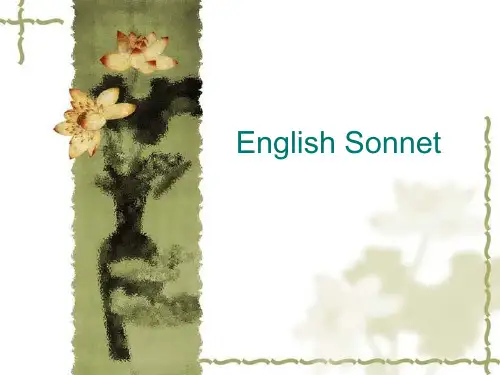
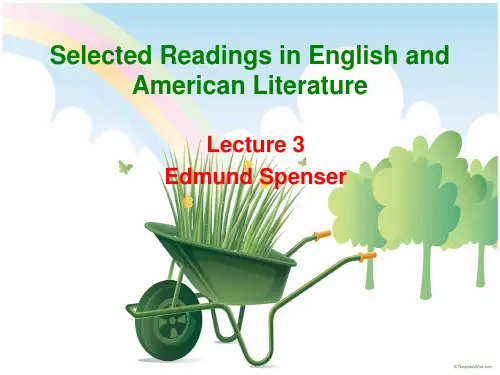
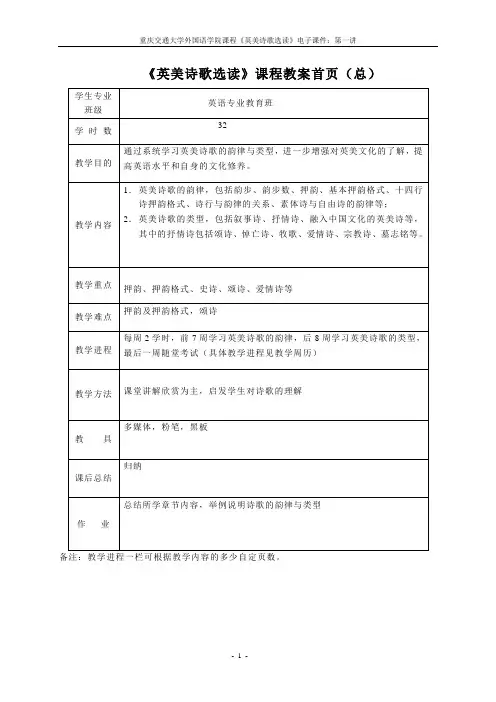
备注:教学进程一栏可根据教学内容的多少自定页数。
备注:教学进程一栏可根据教学内容的多少自定页数。
第一讲英美诗歌的韵步第一节韵步的定义与种类韵步(foot,也被称为音步),是由音节(syllable)组成的,因此,首先要了解什么是音节。
音节由音素(phone)构成,它是语音中最小的不可再分解的单位,是字母组合后的读音标记。
音素靠听觉辨认,字母靠视觉辨认,音素属于读音系统,字母属于拼写系统。
例如,scansion [′skæn∫зn]由8个字母拼写而成,只有7个音素。
英语音素分为元音(vowel)和辅音(c onsonant),共有48个。
音节是英语的发音单位,由一个元音或者由一个元音同一个或若干个辅音构成。
音节可分为单音节、双音节、多音节三类。
单音节:you,day,me,big,make,bar等。
双音节:begin,open,foolish,summer,mountain等。
多音节:w onderful,revolution,satisfactory等。
辅音也可构成音节,如people,rhythm中的ple和thm都属于一个音节。
每个英语单词都有一个重读音节,其重读音节是固定的。
如husband,共两个音节,第一个音节重读;express有两个音节,第二个音节重读;beautiful有三个音节,第一个音节重读;religion有三个音节,第二个音节重读;subterranean有四个音节,第三个音节重读。
在短语或句子中,冠词和介词一般不重读。
如在in the morning,on a desk中,in、the、on、a都不重读。
弄清楚什么是音节,就可以理解什么是韵步了。
韵步是一个或两个重读音节和一个或两个非重读音节的排列组合。
其类型如下:韵步类型表第二节韵步类型举例一、抑扬格抑扬格是一个非重读音节和一个重读音节的排列组合。
英语诗歌以抑扬格韵步为主,如莎士比亚十四行诗《我可以把你比作夏天吗?》最后两行的韵步划分如下(每个韵步由竖杠“|”隔开,“_”代表非重读音节,“/”代表重读音节):_ /. _ / _ / _ / _ /So long |as men |can breathe |or eyes |can see,_ / _ / _ / _ / _ /So long |lives this |and this |gives life |to thee. 1(William Shakespeare: Shall I Compare Thee to a Summer’ Day)每个韵步都是两个音节,且每个韵步都是一个非重读音节加一个重读音节构成。

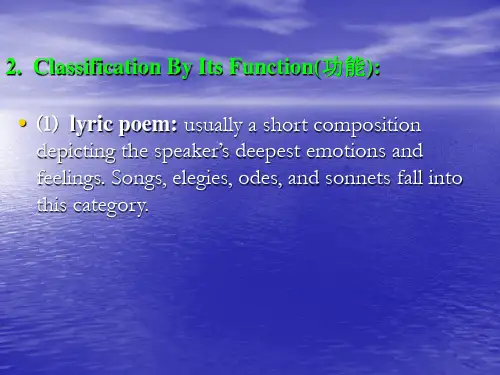
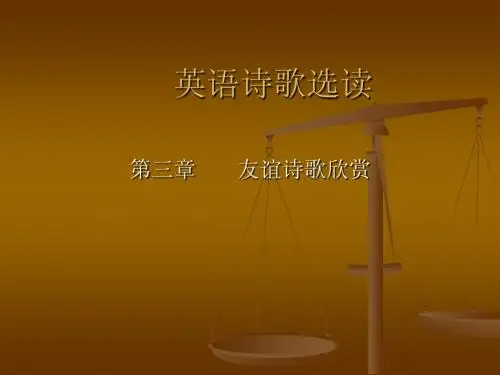
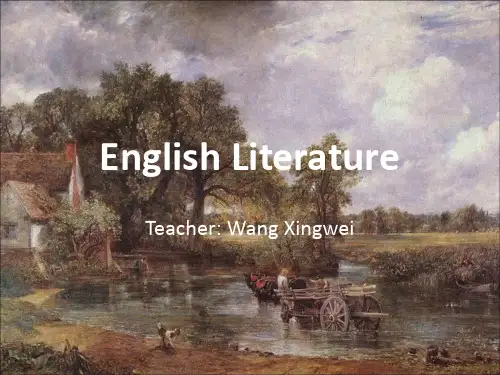
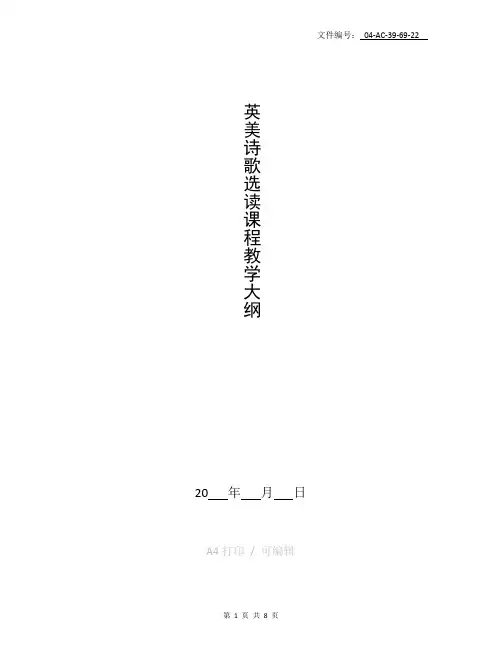
英美诗歌选读课程教学大纲20 年月日A4打印/ 可编辑“英美诗歌选读”课程教学大纲教研室主任:王莉执笔人:曹英慧一、课程基本信息开课单位:外国语学院课程名称:英美诗歌选读课程编号:04188043英文名称:Selected Readings of British and American Poetry课程类型:专业方向限选课总学时:36 理论学时:实验学时:学分:2开设专业:英语专业先修课程:英国文学史及选读(04102613)二、课程任务目标(一)课程任务《英美诗歌赏析》是一门英语专业文学方向限选课程。
对于英语专业学生来说,诗歌作为英语语言学习的重要组成部分,是英语知识结构的一个不可或缺的部分。
诗歌所包含的语言特征、修辞手段和细腻的感情都是英语语言丰富表现能力的集中体现。
另外,诗歌也是增进英语语言能力的重要途径。
诗歌的字里行间都充满了意义,弦外之音、话外之语,它对语言的超常使用将使人们对英语的多种表现手法更加敏感,对英语的特殊表达习惯更加熟悉。
总之,学习诗歌是英语专业学生提高英语水平、提高人文素养以及丰富自己的语言和思想的重要手段。
本课程按照诗歌主题为脉络,介绍诗歌基本知识,梳理英美诗歌的不同流派及其风格,使学生掌握相关韵律法则,引导学生品味诗歌之美,挖掘诗歌内涵,感受诗人寄托在诗中的思想和情愫,进而能够独立进行诗歌阅读、欣赏甚至诗歌翻译及创作。
(二)课程目标具体来说,本课程的教学应达到以下目的和要求:1. 基本诗歌阅读能力:使学生初步了解英、美诗歌的特点、常见修辞手法,英语诗歌的基本要素、相关知识;2. 初步鉴赏能力:能读懂难度适中的英文诗歌,理解字面意思,并能指出主题、韵律形式等,帮助学生进一步感受诗歌中的象征、意象等,挖掘诗歌内涵,领会诗歌的奥妙。
3. 书面表达能力:能就一般或专业性主题撰写简单诗歌评论,流利自如地表达个人观点,做到文章选题合理、结构清晰、内容丰富、逻辑性强。
4. 翻译能力:能翻译所学英语诗歌,译文力争信、达、雅,尽力传达出原文神韵。
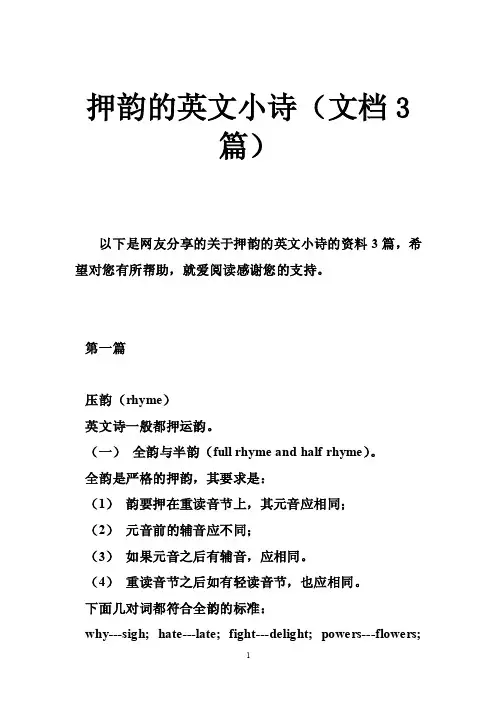
押韵的英文小诗(文档3篇)以下是网友分享的关于押韵的英文小诗的资料3篇,希望对您有所帮助,就爱阅读感谢您的支持。
第一篇压韵(rhyme)英文诗一般都押运韵。
(一)全韵与半韵(full rhyme and half rhyme)。
全韵是严格的押韵,其要求是:(1)韵要押在重读音节上,其元音应相同;(2)元音前的辅音应不同;(3)如果元音之后有辅音,应相同。
(4)重读音节之后如有轻读音节,也应相同。
下面几对词都符合全韵的标准:why---sigh; hate---late; fight---delight; powers---flowers;today---away; ending---bending.如果仅是元音字母相同,读音不同,不符合全韵:如: blood----hood; there---here; gone---alone; daughter----laughter. 这种情形被称为―眼韵‖(eye rhyme),虽然诗人有时用之,但不是真正的押韵。
仅是辅音相同或仅是元音相同的属半韵:元音不同,其前后的辅音相同,这叫谐辅韵(consonance)如:black, block; creak, croak; reader, rider; despise, dispose. 元音相同,其后的辅音相同者叫谐元韵(assonance),如lake, fate; time, mind.(二)尾韵与行内韵(end rhyme and internal rhyme)押在诗行最后一个重读音节上,叫尾韵。
这是英文诗歌最常见的押韵部位。
诗行中间停顿处的重读音节与该行最后一个重读音节押韵者,叫行内韵。
如:Spring, the sweet spring, is the year’s pleasant king;Then blooms each thing, then maids dance in a ring,(三)男韵与女韵((masculine rhyme and feminine rhyme) 所押的韵音局限于诗行中重读的末尾音节上,称男韵,也叫单韵,听起来强劲有力。
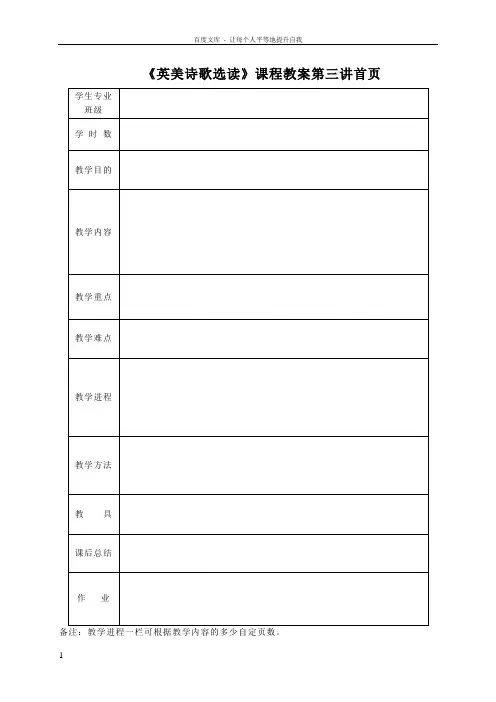
《英美诗歌选读》课程教案第三讲首页学生专业班级学时数教学目的教学内容教学重点教学难点教学进程教学方法教具课后总结作业备注:教学进程一栏可根据教学内容的多少自定页数。
第三讲英美诗歌的押韵押韵(rhyme)是指一个音节的读音在以后音节读音中的重复,或是一个单词的最后一个音节或几个音节的读音在以后音节相应位置的读音重复。
从押韵的位置看,押韵主要有头韵(alliteration)、尾韵(end rhyme)和中间韵或腹韵(internal rhyme)。
尾韵又分全韵(perfect rhyme)和非全韵(imperfect rhyme)两种。
全韵要求押韵的辅音和元音都相同,非全韵又包括只是元音相同但辅音不押韵的元韵(assonance)和只押辅音不押元音的和韵(consonance),另外,还有从拼写上看起来似乎押韵但实际读音并不押韵的目韵(eye rhyme, visual rhyme or sight rhyme)等。
第一节头韵头韵是指一行(节)诗中几个词开头的辅音相同,形成押韵。
如克里斯蒂娜•罗塞蒂的《歌》前两诗节:When I am dead, my dearest,Sing no sad songs for me;Plant thou no rose at my head,Nor shady cypress tree:Be the green grass above meWith showers and dewdrops wet;And if thou wilt, remember,And if thou wilt, forget. 12(Samuel Taylor Coleridge: The Rime of the Ancient Mariner)前三行里,头韵[f]重复七次。
这个摩擦送气的清辅音模仿柔风轻涛的声音,创造出一种宁静的意境。
第四行里的两个[s]音宛如和风吹过沉寂海面而发出的咝咝声。
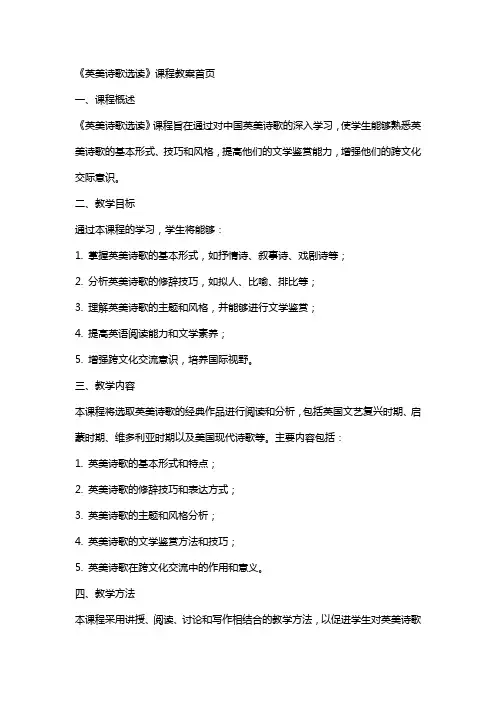
《英美诗歌选读》课程教案首页一、课程概述《英美诗歌选读》课程旨在通过对中国英美诗歌的深入学习,使学生能够熟悉英美诗歌的基本形式、技巧和风格,提高他们的文学鉴赏能力,增强他们的跨文化交际意识。
二、教学目标通过本课程的学习,学生将能够:1. 掌握英美诗歌的基本形式,如抒情诗、叙事诗、戏剧诗等;2. 分析英美诗歌的修辞技巧,如拟人、比喻、排比等;3. 理解英美诗歌的主题和风格,并能够进行文学鉴赏;4. 提高英语阅读能力和文学素养;5. 增强跨文化交流意识,培养国际视野。
三、教学内容本课程将选取英美诗歌的经典作品进行阅读和分析,包括英国文艺复兴时期、启蒙时期、维多利亚时期以及美国现代诗歌等。
主要内容包括:1. 英美诗歌的基本形式和特点;2. 英美诗歌的修辞技巧和表达方式;3. 英美诗歌的主题和风格分析;4. 英美诗歌的文学鉴赏方法和技巧;5. 英美诗歌在跨文化交流中的作用和意义。
四、教学方法本课程采用讲授、阅读、讨论和写作相结合的教学方法,以促进学生对英美诗歌的理解和鉴赏能力的提高。
具体方法包括:1. 讲授:对英美诗歌的基本形式、修辞技巧和主题风格进行系统的讲解;2. 阅读:学生将阅读和分析经典英美诗歌,提高他们的文学鉴赏能力;3. 讨论:学生将就诗歌的形式、主题和风格进行分组讨论,促进彼此的交流和思考;五、评价方式本课程的评价方式包括课堂参与、作业完成和期末考试三个部分,以全面评估学生在课程中的学习成果。
具体评价方式包括:1. 课堂参与:学生的课堂发言和讨论表现将作为评价的一部分;2. 作业完成:学生的作业、读后感、评论和短文将作为评价的一部分;3. 期末考试:期末考试将全面测试学生对课程内容的掌握程度。
六、教学资源1. 教材:《英美诗歌选读》教材,用于系统地介绍和分析英美诗歌;2. 辅助阅读材料:相关的英美诗歌集、评论文章和参考书籍;3. 多媒体教学设备:用于展示诗歌原文、播放诗歌朗诵和相关的视频资料;4. 网络资源:用于查找和了解诗人的生平和创作背景。
《英美诗歌选读》课程教案首页一、课程概述课程名称:英美诗歌选读课程类型:专业选修课学分:2学分学时:32学时授课对象:英语专业二年级学生二、课程目标通过本课程的学习,使学生了解英美诗歌的基本特点、形式和技巧,提高学生对英美诗歌的鉴赏能力和批评能力,丰富学生的英美文化知识,激发学生对英美文学的兴趣和热情。
三、教学内容英美诗歌的基本概念、术语和分类英美诗歌的形式和技巧(如押韵、节奏、象征、隐喻等)英美诗歌的历史发展概述重点诗人及其代表作品四、教学方法讲授与讨论相结合:教师对相关知识点进行讲解,学生就诗歌作品进行分析和讨论。
案例分析:通过分析具体诗歌作品,使学生掌握英美诗歌的形式和技巧。
小组合作:学生分组进行诗歌鉴赏和批评,培养学生的团队协作能力。
五、课程安排第一周:英美诗歌的基本概念和术语第二周:英美诗歌的形式和技巧(押韵、节奏)第三周:英美诗歌的形式和技巧(象征、隐喻)第四周:英美诗歌的历史发展概述第五周:重点诗人及其代表作品(莎士比亚、雪莱等)六、教学评估1. 平时成绩:包括课堂参与、讨论、作业等,占总成绩的30%。
2. 诗歌鉴赏报告:学生选择一首英美诗歌进行深入分析,占总成绩的20%。
3. 期末考试:包括选择题、简答题和作文,占总成绩的50%。
七、课程资源1. 教材:《英美诗歌选读》,张伯伦著。
2. 辅助教材:《英美诗歌鉴赏辞典》,王守仁著。
3. 网络资源:英美诗歌相关网站、论坛、博客等。
八、课程要求1. 学生需按时完成作业,积极参与课堂讨论。
2. 学生需阅读教材和辅助教材,了解英美诗歌的基本知识和作品。
3. 学生需充分利用网络资源,拓宽自己的视野。
本课程旨在帮助学生了解英美诗歌的基本特点、形式和技巧,提高学生对英美诗歌的鉴赏能力和批评能力。
通过本课程的学习,学生不仅能够丰富自己的英美文化知识,还能够激发对英美文学的兴趣和热情。
希望学生能够将所学知识运用到实际生活和未来工作中,不断提高自己的综合素质。
自考《英美文学选读》(英)维多利亚时期(3)-1III. Alfred Tennyson1.一般识记His Life & Literary CareerAlfred Tennyson (1809-1892) is certainly the most representative Victorian poet. His poetry voices the doubt & the faith,the grief & the joy of the English people in an age of fast social changes.He was born at Somersby,Linconshire,the fourth son of a rather learned clergyman. In 1827,he & his elder brother published Poems by Two Brothers. In this juvenile work the influence of Byron & an attraction to oriental themes were shown. He was educated at the Trinity College,Cambridge & published his first signed work Poems,Chiefly Lyrical (1830) there. In 1832,one year after he left Cambridge,he published Poems,which contained a variety of poems,beautiful in melody & rich in imagery. In 1842,his next issue of Poems came out,collected in the book are the dramatic monologue “Ulysses”,the epic narrative “ Morte d’’Arthur,” the exquisite idylls “Dora” & “ The Gardener’’s Daughter,” etc. In 1847,The Princess was published. Written in blank verse,it deals with the theme of women’’s rights & position. In 1850,Tennyson was appointed the Poet Laureate & he published his greatest work In Memoriam. The rest years of Tennyson’’s life was comfortable & peaceful,but he never stopped writing. In 1855,Tennyson published a monodrama Maud,a collection of short lyrics. Among the other works of his later period,“Rizpah,” “Enoch Arden,” “ Merlin & the Gleam” & “ Crossing the Bar” are worthy of note.2.识记His major poetic works & their theme1) In MemoriamPresumably it is an elegy on the death of Hallam,yet less than half of its l00 pieces are directly connected with him. The poet here does not merely dwell on the personal bereavement. As a poetic diary,the poem is al so an elaborate & powerful expression of the poet’’s philosophical & religious thoughts - his doubts about the meaning of life,the existence of the soul & the afterlife,& his faith in the power of love & the soul’’s instinct & immortality. Such doubts & beliefs were shared by most people in an age when the old Christian belief was challenged by new scientific discoveries,though to most readers today,the real attraction of the poem lies more in its profound feeling & artistic beauty than in the philosophical & religious reflections. The familiar trance-like experience,mellifluous rhythm & pictorial descriptions make it one of the best elegies in English literature.2) Idylls of the Kin g (1842-1885)It is his most ambitious work which took him over 30 years to complete. It is made up of 12 books of narrative poems,based on the Celtic legends of King Arthur & his Knights of the Round Table. But it is not a mere reproduction of the old legend,though. It is a modern interpretation of the classic myth. For one thing,the moral standards & sentiments reflected in the poem belong to the Victorians rather than to the medieval royal people. For another,the story of the rise & fall of King Arthur is,in fact,meant to represent a cyclic history of western civilization,which ,in Tennyson’’s mind ,is going on a spiritual decline & will end in destruction.3.领会Artistic Features of His PoetryTennyson is a real artist. He has the natural power of linking visual pictures with musicalexpressions,& these two with the feelings. He has perfect control of the sound of English,& a sensitive ear,an excellent choice & taste of words. His poetry is rich in poetic images & melodious language,& noted for its lyrical beauty & metrical charm. His works are not only the products of the creative imagination of a poetic genius but also products of a long & rich English heritage. His wonderful works manifest all the qualities of England’’s great poets. The dreamines s of Spenser,the majesty of Milton,the natural simplicity of Wordsworth,the fantasy of Blake & Coleridge,the melody of Keats & Shelley,& the narrative vigor of Scott & Byron,—— all these striking qualities are evident on successive pages of Tennyson’’s poetry.4. 应用Selected Readings(1) BreakThis short lyric is written in memory of Tennyson’’s best friend,Arthur Hallam,whose death has a lifelong influence on the poet. Here,the poet’’s own feelings of sadness are contrasted with the carefree,innocent joys of the children & the unfeeling movement of the ship & the sea waves. The beauty of the lyric is to be found in the musical language & in the association of sound & images with feelings & emotions. The poem contains 4 quatrains,with combined iambic & anapaestic feet. Most lines have three feet & some four. The rhyme scheme isa b c b.(2) Crossing the BarThis poem was written in the later years of Tennyson’’s life. Although not the last poem written by Tennyson in his long creative career,this poem appears,at his request,as the final poem in all collections of his works. The scene is sketched with a few strokes:sunset & the evening star,the twilight and the evening bell,& then the dark. The ship is ready to go out of the harbor. It will cross the bar & reach the vast open sea for the long voyage that it is to make. The allegory of the poem is clear. Tennyson is in the evening of life,& the “clear call” of death will come soon. But when he has crossed the border between life & death to go on that voyage beyond the bound of Time & Place,he hopes then to see his “Pilot,” God,face to face. From the moving imagery & the pleasant sound of the poem,we can feel his fearlessness towards death,his faith in God & an afterlife.。
备注:教学进程一栏可根据教学内容的多少自定页数。
备注:教学进程一栏可根据教学内容的多少自定页数。
第一讲英美诗歌的韵步第一节韵步的定义与种类韵步(foot,也被称为音步),是由音节(syllable)组成的,因此,首先要了解什么是音节。
音节由音素(phone)构成,它是语音中最小的不可再分解的单位,是字母组合后的读音标记。
音素靠听觉辨认,字母靠视觉辨认,音素属于读音系统,字母属于拼写系统。
例如,scansion [′skæn∫зn]由8个字母拼写而成,只有7个音素。
英语音素分为元音(vowel)和辅音(consonant),共有48个。
音节是英语的发音单位,由一个元音或者由一个元音同一个或若干个辅音构成。
音节可分为单音节、双音节、多音节三类。
单音节:you,day,me,big,make,bar等。
双音节:begin,open,foolish,summer,mountain等。
多音节:wonderful,revolution,satisfactory等。
辅音也可构成音节,如people,rhythm中的ple和thm都属于一个音节。
每个英语单词都有一个重读音节,其重读音节是固定的。
如husband,共两个音节,第一个音节重读;express有两个音节,第二个音节重读;beautiful有三个音节,第一个音节重读;religion有三个音节,第二个音节重读;subterranean有四个音节,第三个音节重读。
在短语或句子中,冠词和介词一般不重读。
如在in the morning,on a desk中,in、the、on、a都不重读。
弄清楚什么是音节,就可以理解什么是韵步了。
韵步是一个或两个重读音节和一个或两个非重读音节的排列组合。
其类型如下:韵步类型表第二节韵步类型举例一、抑扬格抑扬格是一个非重读音节和一个重读音节的排列组合。
英语诗歌以抑扬格韵步为主,如莎士比亚十四行诗《我可以把你比作夏天吗?》最后两行的韵步划分如下(每个韵步由竖杠“|”隔开,“_”代表非重读音节,“/”代表重读音节):_ /. _ / _ / _ / _ /So long |as men |can breathe |or eyes |can see,_ / _ / _ / _ / _ /So long |lives this |and this |gives life |to thee. 1(William Shakespeare: Shall I Compare Thee to a Summer’ Day)每个韵步都是两个音节,且每个韵步都是一个非重读音节加一个重读音节构成。
英美诗歌选读第三讲[大] [中] [小]英美诗歌的押韵押韵(rhyme)是指一个音节的读音在以后音节读音中的重复,或是一个单词的最后一个音节或几个音节的读音在以后音节相应位置的读音重复。
从押韵的位置看,押韵主要有头韵(alliteration)、尾韵(end rhyme)和中间韵或腹韵(internal rhyme)。
尾韵又分全韵(perfect rhyme)和非全韵(imperfect rhyme)两种。
全韵要求押韵的辅音和元音都相同,非全韵又包括只是元音相同但辅音不押韵的元韵(assonance)和只押辅音不押元音的和韵(consonance),另外,还有从拼写上看起来似乎押韵但实际读音并不押韵的目韵(eye rhyme,visual rhyme or sight rhyme)等。
第一节头韵头韵是指一行(节)诗中几个词开头的辅音相同,形成押韵。
如克里斯蒂娜•罗塞蒂的《歌》前两诗节:When I am dead,my dearest,Sing no sad songs for me;Plant thou no rose at my head,Nor shady cypress tree:Be the green grass above meWith showers and dewdrops wet;And if thou wilt,remember,And if thou wilt,forget. [1](Christina Rossetti:Song)第一行的dead / dearest,第二行的sing / sad / songs,第五行的green / grass,第六行的with / wet押头韵。
又如柯尔律治的《古舟子咏》第103~第106行:The fair breeze blew,the white foam flew,The furrow followed free,We were the first that ever burstInto that silent sea. [2](Samuel Taylor Coleridge:The Rime of the Ancient Mariner)前三行里,头韵[f]重复七次。
这个摩擦送气的清辅音模仿柔风轻涛的声音,创造出一种宁静的意境。
第四行里的两个[s]音宛如和风吹过沉寂海面而发出的咝咝声。
头韵在这里的使用,令读者有身临其境之感。
另外,中间韵blew / flew,first / burst,furrow / followed,尾韵free / sea形成悦耳动听的韵味和节奏感。
再如莎士比亚编号为71的十四行诗前八行:No longer mourn for me when I am deadThan you shall hear the surly sullen bellGive warning to the world that I am fledFrom this vile world with vilest worms to dwell.Nay,if you read this line,remember notThe hand that writ it;for I love you soThat I in your sweet thoughts would be forgotIf thinking on me would make you woe. [3]每行都有不同的头韵。
第一行为mourn / me,第二行为surly / sullen,第三行为warning / world,第四行为world / worm,第五行为read / remember,第八行为me / make和would / woe。
第二行、第三行和第五行为than / that / this,第七行和第八行为thoughts / thinking。
这样的不同首字母交替出现在一个诗节中,可以称为交叉头韵。
诗人在使用头韵时,还使用一种声音的重复,通过这种声音的重复表达一种独特的情感。
如多恩的《歌》:When thou sigh’st,thou sigh’st not windBut sigh’st my soul away;When thou weep’st,unkindly kind,My life’s blood doth decay.It cannot be,That thou lov’st me,as thou say’st,If in thine my life thou waste,Thou art the best of me. [4](John Donne:Song)此诗节使用的头韵有when / wind / weep / waste,sigh / soul / say,doth / decay,blood / be / best,thou / then / that等。
另外,在sigh、kindly、thine、my和life中有频繁的元音字母i,此音暗示悲伤和抑郁,加上它是一个长元音,自然就减缓了诗行自然的快节奏运动,哀伤和抑郁之情得到了充分的表现。
同样的诗歌技巧也体现在爱伦•坡的《乌鸦》之中,如该诗的最后一节:And the Raven,never flitting,still is sitting,still is sittingOn the pallid bust of Pallas just above my chamber door;And his eyes have all the seeming of a demon that is dreaming,And the lamp-light o’er him streaming throws his shadow on the floor;And my soul from out that shadow that lies floating on the floorShall be lifted –nevermore此诗节中除了各行的头韵(still / sitting,pallid / Pallas,his / have,lamp / light,from / floating / floor),还有内韵(flitting / sitting,seeming / dreaming等),贯穿整个诗节的短元音[i]、[æ],长元音[i:]、[o:]和双元音[?u]生动地传达出了主人公的痛苦和绝望。
第二节尾韵尾韵(end rhyme)指行尾押韵单词最后的重读元音及其后面的辅音在读音上相同,而元音前面的辅音则不能相同。
也就是说,元音以及元音后面的辅音押韵,而元音前面的辅音则不押韵。
这种韵又被称为全韵(perfect rhyme)。
根据音节的数量,可分为单音节尾韵(single rhyme)、双音节尾韵(double rhyme)和三重音节尾韵(triple rhyme)。
单音节尾韵又称男韵或阳韵(masculine rhyme),是在诗行结尾重读音节之间出现的最普遍的押韵。
如米勒《在太平洋之滨》第二诗节:Above yon gleaming skies of goldOne lone imperial peak is seen;While gathered at his feet in greenTen thousand foresters are told.And all so still!So still the airThat duty drops the web of care. [6](Joaquin Miller:By the Pacific Ocean)第一、四行押韵,第二、三行押韵,第五、六行押韵,都是重读单音节。
虽然是单音节押韵,但它只要求一个音节押韵,而不要求押韵的一个音节是一个单音节单词。
例如叶芝《走过柳园》第一节:Down by the sally gardens my love and I did meet;She pass’d the sally gardens with little snow-white feet.She bid me take love easy,as the leaves grow on the tree;But I,being young and foolish,with her would not agree. [7](W. B. Yeats:Down by the Sally Gardens)这里第四行的agree就是一个双音节单词,它只在第二个音节上与前行的tree押韵,而且它是重读音节。
双音节韵又称女韵或阴韵(feminine rhyme),其基本特征是行尾单词最后两个音节押韵,其中倒数第二个音节是重读音节,而最后一个音节是非重读音节。
由于其读音是重读加非重读结构,因此它又称扬抑格韵(trochaic rhyme)。
如华兹华斯的《写于三月》前四行:The cock is crowing,The stream is flowing,The small birds twitter,The lake doth glitter. [8](William Wordsworth:Written in March at Brother’s Water)行尾的crowing / flowing,twitter / glitter相互押韵。
两组押韵都是由双音节单词组成,每个单词的第一个音节为重读音节,第二个音节为非重读音节。
又如丁尼生《女郎夏洛特》第一部分的第二诗节:Willows whiten,aspens quiver,Little breezes dusk and shiverThrough the wave that runs foreverBy the island in the riverFlowing down to Camelot.Four grey walls,and four grey towers,Overlook a space of flowers,And the silent isle imbowersThe Lady of Shalott. [9](Alfred Tennyson:The Lady of Shalott,Part I)行尾的quiver / shiver / river,towers / flowers / imbowers相互押韵,除了imbowers,其余单词都是双音节单词,都是第一个音节为重读,第二个音节为非重读。